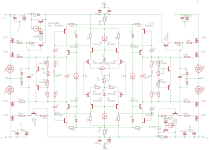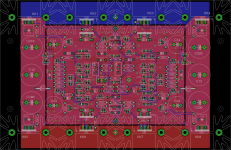Hello Everyone!
You might remember that about half a year ago I built a hybrid opamp MOSFET fully symmetrical headphone amp that I call M4:
https://www.diyaudio.com/community/...ial-hybrid-opamp-mosfet-headphone-amp.409976/
It's working quite well although I cannot say anything about noise figures or THD+N.
This amp was always meant to be a stepping stone up to the big leagues of something high-end. This is where I am seeking guidance from the community. These are my ideas for future upgrades:
- Raise the PSU voltage to +-15V, upgrade the opamp to OPA1633 and cascode the MOSFETs like in the AMB Beta22 amp with the same topology except for driving the MOSFETs. That would be identical to the current version (2 JFET CCS bias of the OPAMP through the + and - rails). I believe that this setup would provide optimal noise (OPAMP VAS with -132dB noise) and THD+N (cascoded output stage)
- Use the fully discreet design of the beta24 (https://www.amb.org/audio/beta24/) with the output stage of the beta22 (https://www.amb.org/audio/beta22/) with a single regulated PSU (sigma 22). This could be the ultimate headphone amp if done right. The problem with it is that it needs matched components. I could source the input JFETs from diyaudiostore for about 100USD (quite a bit for 8 JFETs but still better than no JFETs), but I am having trouble in locating a good source for the BC550 BC560 BJTs. Especially, that I need 24 of each of them. I could get them through ebay (questionable) or dig through the entire internet. I could also use some better complementary BJT pairs based on the Horowitz book, although, I couldn't find obvious ones to use. I could also use SMD JFETs and BJTs but then I would need to redesign the circuit and the PCB completely.
Here is what I have for this amp:
Schematic:

PCB:

Do you see any potential upgrades in either of these projects? Which one would you recommend pursuing (if any)?
Happy Sunday!
Cheers!
You might remember that about half a year ago I built a hybrid opamp MOSFET fully symmetrical headphone amp that I call M4:
https://www.diyaudio.com/community/...ial-hybrid-opamp-mosfet-headphone-amp.409976/
It's working quite well although I cannot say anything about noise figures or THD+N.
This amp was always meant to be a stepping stone up to the big leagues of something high-end. This is where I am seeking guidance from the community. These are my ideas for future upgrades:
- Raise the PSU voltage to +-15V, upgrade the opamp to OPA1633 and cascode the MOSFETs like in the AMB Beta22 amp with the same topology except for driving the MOSFETs. That would be identical to the current version (2 JFET CCS bias of the OPAMP through the + and - rails). I believe that this setup would provide optimal noise (OPAMP VAS with -132dB noise) and THD+N (cascoded output stage)
- Use the fully discreet design of the beta24 (https://www.amb.org/audio/beta24/) with the output stage of the beta22 (https://www.amb.org/audio/beta22/) with a single regulated PSU (sigma 22). This could be the ultimate headphone amp if done right. The problem with it is that it needs matched components. I could source the input JFETs from diyaudiostore for about 100USD (quite a bit for 8 JFETs but still better than no JFETs), but I am having trouble in locating a good source for the BC550 BC560 BJTs. Especially, that I need 24 of each of them. I could get them through ebay (questionable) or dig through the entire internet. I could also use some better complementary BJT pairs based on the Horowitz book, although, I couldn't find obvious ones to use. I could also use SMD JFETs and BJTs but then I would need to redesign the circuit and the PCB completely.
Here is what I have for this amp:
Schematic:

PCB:

Do you see any potential upgrades in either of these projects? Which one would you recommend pursuing (if any)?
Happy Sunday!
Cheers!
Since my post has not generated much interest, I did some investigation to figure out what to do.
With the same settings, I get the following numbers for M4 (circuit I build), M4 cascode (cascoded MOSFET power stage), and B44 (fully differential Beta22):
M4:
THD: 0.054408%
noise: ~53nV/sqrt(Hz)
M4 cascode:
THD: 0.032382%
noise: ~55nV/sqrt(Hz)
B44:
THD: 0.028857%
noise:<30nV/sqrt(Hz)
These numbers are not quite accurate because LTSpice failed to converge with lower timesteps and better relative tolerance. I think it is an okay comparison between them, though.
I tried to use different BJTs other than the BC550C/BC560C pairs because getting them is not straightforward. Especially since they need to be 10% beta-matched. Neither ZTX851/ZTX951 nor 2SD2653/2SB1690 pairs worked. The former produced noise amplification around 1MHz no matter how I tried to compensate it, I could only suppress it by eating into the audible range. The latter has a peak collector emitter voltage of 12V and simulations showed much higher with +-24V rails. I could use BC850/BC860 but I'd rather not redesign the whole PCB. Also, matching SMD transistors is not that much fun. I also looked at the THAT transistors but their beta is low and getting npn and pnp matched is difficult. I could maybe degenerate them in a paired way but again, I would rather avoid redesigning the whole PCB for THAT quads.
I have the same issue with the input JFETs, although I could source them (for quite a bit).
Anyhow, I am going to build this discreet amp one way or another. Any suggestion is very welcome 😉 (including a good source of low noise BJTs). 🙂
Cheers!
With the same settings, I get the following numbers for M4 (circuit I build), M4 cascode (cascoded MOSFET power stage), and B44 (fully differential Beta22):
M4:
THD: 0.054408%
noise: ~53nV/sqrt(Hz)
M4 cascode:
THD: 0.032382%
noise: ~55nV/sqrt(Hz)
B44:
THD: 0.028857%
noise:<30nV/sqrt(Hz)
These numbers are not quite accurate because LTSpice failed to converge with lower timesteps and better relative tolerance. I think it is an okay comparison between them, though.
I tried to use different BJTs other than the BC550C/BC560C pairs because getting them is not straightforward. Especially since they need to be 10% beta-matched. Neither ZTX851/ZTX951 nor 2SD2653/2SB1690 pairs worked. The former produced noise amplification around 1MHz no matter how I tried to compensate it, I could only suppress it by eating into the audible range. The latter has a peak collector emitter voltage of 12V and simulations showed much higher with +-24V rails. I could use BC850/BC860 but I'd rather not redesign the whole PCB. Also, matching SMD transistors is not that much fun. I also looked at the THAT transistors but their beta is low and getting npn and pnp matched is difficult. I could maybe degenerate them in a paired way but again, I would rather avoid redesigning the whole PCB for THAT quads.
I have the same issue with the input JFETs, although I could source them (for quite a bit).
Anyhow, I am going to build this discreet amp one way or another. Any suggestion is very welcome 😉 (including a good source of low noise BJTs). 🙂
Cheers!
I built B22 and I remember I got better THD, actually measured after the build. Your noise numbers are much lower, but I don't trust those in LTSpice.
I love my B22, but I prefer my SCG...which pauses the question: Do you really want THD to be your target?
If THD is your target, then you are on the right track. I cannot tell you more because I am not competent enough. B22 all discrete, fully complementary, cascoded design is certainly hard to beat. I just wish it had infinite power output for modern and very silly headphones.
PS: Omicron is even harder to beat at THD.
I love my B22, but I prefer my SCG...which pauses the question: Do you really want THD to be your target?
If THD is your target, then you are on the right track. I cannot tell you more because I am not competent enough. B22 all discrete, fully complementary, cascoded design is certainly hard to beat. I just wish it had infinite power output for modern and very silly headphones.
PS: Omicron is even harder to beat at THD.
Thanks for the input! I have not seen the SCG amp yet, nor did I hear the Omicron. The latter seems like a relatively easy build. Especially since I could use a PSU I already have.
The LTSpice numbers are probably meaningless and the overall sonic preference is more important. Still, it's good to know what to expect from the amplifier.
The LTSpice numbers are probably meaningless and the overall sonic preference is more important. Still, it's good to know what to expect from the amplifier.